A Ship Detection and Imagery Scheme for Airborne Single-Channel SAR in Coastal Regions
Abstract
:1. Introduction
2. Modified Prescreening Algorithm
2.1. Preprocessing
2.2. K-Lognormal Model for Prescreening
3. Ship Discrimination
3.1. Radial Motion Judgment of Target to Be Detected
- (1)
- Envelope alignment to remove the envelope migration caused by the overall movement of the target.
- (2)
- Phase compensation to remove the phase error caused by the overall movement of the target.
- (3)
- Keystone transform; removing the over distance cell migration caused by the rotation of the target itself.
- (4)
- Azimuth imaging.
3.2. Entropy Judgment of Target to Be Detected
4. Simulation Verification and Processing of Field Data
4.1. Simulation Data Verification
4.2. Processing Results of Field Data
5. Conclusions
Author Contributions
Funding
Data Availability Statement
Acknowledgments
Conflicts of Interest
References
- Cumming, G.; Wong, F.H. Digital Processing of Synthetic Aperture Radar Data. Algorithms Implement. 2015, 1, 108–110. [Google Scholar]
- Chen, J.; Zhang, J.; Jin, Y.; Yu, H.; Liang, B.; Yang, D.G. Real-Time Processing of Spaceborne SAR Data with Nonlinear Trajectory Based on Variable PRF. IEEE Trans. Geosci. Remote Sens. 2022, 60, 1–12. [Google Scholar] [CrossRef]
- Li, Z.; Xing, M.; Liang, Y.; Gao, Y.; Chen, J.; Huai, Y.; Zeng, L.; Sun, G.C.; Bao, Z. A frequency-domain imaging algorithm for highly squinted SAR mounted on maneuvering platforms with nonlinear trajectory. IEEE Trans. Geosci. Remote Sens. 2016, 54, 4023–4038. [Google Scholar] [CrossRef]
- Askari, F.; Zerr, B. Automatic Approach to Ship Detection in Spaceborne Synthetic Aperture Radar Imagery: An Assessment of Ship Detection Capability Using Radarsat. Technical Report SACLANTCEN-SR-338. 2000. Available online: https://www.semanticscholar.org/paper/An-Automatic-Approach-to-Ship-Detection-in-Aperture-Askari-Zerr/0881f3c222242988c05442fb6475adf94064128f?p2df (accessed on 7 June 2022).
- Velotto, D.; Nunziata, F.; Migliaccio, M.; Lehner, S. Dual-Polarimetric TerraSAR-X SAR Data for Target at Sea Observation. IEEE Geosci. Remote Sens. Lett. 2013, 10, 1114–1118. [Google Scholar] [CrossRef]
- Sun, Z.; Dai, M.; Leng, X.; Lei, Y.; Xiong, B.; Ji, K.; Kuang, G. An Anchor-Free Detection Method for Ship Targets in High-Resolution SAR Images. J. Sel. Top. Appl. Earth Obs. Remote Sens. 2021, 14, 7799–7816. [Google Scholar] [CrossRef]
- Chen, J.; Yu, H.; Liang, B.; Peng, J.; Sun, G.C. MoCo/Autofocus in Airborne Synthetic Aperture Radar: A Review. IEEE Geosci. Remote Sens. Mag. 2022, 10, 185–206. [Google Scholar] [CrossRef]
- Gao, G.; Shi, G. Ship Detection in Dual-Channel ATI-SAR Based on the Notch Filter. IEEE Trans. Geosci. Remote Sens. 2017, 55, 4795–4810. [Google Scholar] [CrossRef]
- Gao, G.; Luo, Y.; Ouyang, K.; Zhou, S. Statistical Modeling of PMA Detector for Ship Detection in High-Resolution Dual-Polarization SAR Images. IEEE Trans. Geosci. Remote Sens. 2016, 54, 4302–4313. [Google Scholar] [CrossRef]
- Gao, G.; Wang, X.; Lai, T. Detection of Moving Ships Based on a Combination of Magnitude and Phase in Along-Track Interferometric SAR—Part I: SIMP Metric and Its Performance. IEEE Trans. Geosci. Remote Sens. 2015, 53, 3565–3581. [Google Scholar] [CrossRef]
- Gao, G.; Wang, X.; Lai, T. Detection of Moving Ships Based on a Combination of Magnitude and Phase in Along-Track Interferometric SAR—Part II: Statistical Modeling and CFAR Detection. IEEE Trans. Geosci. Remote Sens. 2015, 53, 3582–3599. [Google Scholar] [CrossRef]
- Leng, X.; Ji, K.; Zhou, S.; Xing, X. Ship Detection Based on Complex Signal Kurtosis in Single-Channel SAR Imagery. IEEE Trans. Geosci. Remote Sens. 2019, 57, 6447–6461. [Google Scholar] [CrossRef]
- Joshi, S.K.; Baumgartnerv, S.V. Automatic CFAR Ship Detection in Single–Channel Range-Compressed Airborne Radar Data. In Proceedings of the 2019 20th International Radar Symposium (IRS), Ulm, Germany, 26–28 June 2019. [Google Scholar] [CrossRef]
- Joshi, S.K.; Baumgartner, S.V. Sea clutter model comparison for ship detection using single channel airborne raw SAR data. In Proceedings of the 12th European Conference on Synthetic Aperture Radar, Aachen, Germany, 4–7 June 2018. [Google Scholar]
- Chen, C.; He, C.; Hu, C.; Pei, H.; Jiao, L. A Deep Neural Network Based on an Attention Mechanism for SAR Ship Detection in Multiscale and Complex Scenarios. IEEE Access 2019, 7, 104848–104863. [Google Scholar] [CrossRef]
- Fu, J.; Sun, X.; Wang, Z.; Fu, K. An Anchor-Free Method Based on Feature Balancing and Refinement Network for Multiscale Ship Detection in SAR Images. IEEE Trans. Geosci. Remote Sens. 2021, 59, 1331–1344. [Google Scholar] [CrossRef]
- Bao, W.; Huang, M.; Zhang, Y.; Xu, Y.; Liu, X.; Xiang, X. Boosting Ship Detection in SAR Images With Complementary Pretraining Techniques. IEEE J. Sel. Top. Appl. Earth Obs. Remote Sens. 2021, 14, 8941–8954. [Google Scholar] [CrossRef]
- Deng, Z.; Sun, H.; Zhou, S.; Zhao, J. Learning Deep Ship Detector in SAR Images From Scratch. IEEE Trans. Geosci. Remote Sens. 2019, 57, 4021–4039. [Google Scholar] [CrossRef]
- Yang, R.; Pan, Z.; Jia, X.; Zhang, L.; Deng, Y. A Novel CNN-Based Detector for Ship Detection Based on Rotatable Bounding Box in SAR Images. IEEE J. Sel. Top. Appl. Earth Obs. Remote Sens. 2021, 14, 1938–1958. [Google Scholar] [CrossRef]
- Zhang, X.; Huo, C.; Xu, N.; Jiang, H.; Cao, Y.; Ni, L.; Pan, C. Multitask Learning for Ship Detection From Synthetic Aperture Radar Images. IEEE J. Sel. Top. Appl. Earth Obs. Remote Sens. 2021, 14, 8048–8062. [Google Scholar] [CrossRef]
- Cui, Z.; Li, Q.; Cao, Z.; Liu, N. Dense Attention Pyramid Networks for Multi-Scale Ship Detection in SAR Images. IEEE Trans. Geosci. Remote Sens. 2019, 57, 8983–8997. [Google Scholar] [CrossRef]
- He, Y.; Gao, F.; Wang, J.; Hussain, A.; Yang, E.; Zhou, H. Learning Polar Encodings for Arbitrary-Oriented Ship Detection in SAR Images. IEEE J. Sel. Top. Appl. Earth Obs. Remote Sens. 2021, 14, 3846–3859. [Google Scholar] [CrossRef]
- Avolio, C.; Zavagli, M.; Paterino, G.; Paola, N.; Costantini, M. A Near Real Time CFAR Approach for Ship Detection on Sar Data Based on a Generalised-K Distributed Clutter Estimation. In Proceedings of the 2021 IEEE International Geoscience and Remote Sensing Symposium IGARSS, Brussels, Belgium, 11–16 July 2021. [Google Scholar] [CrossRef]
- Idicula, S.M.; Paul, B. Real time SAR Ship Detection using novel SarNeDe method. In Proceedings of the 2021 IEEE International Geoscience and Remote Sensing Symposium IGARSS, Brussels, Belgium, 11–16 July 2021. [Google Scholar] [CrossRef]
- Zhu, M.; Hu, G.; Zhou, H.; Wang, S. H2Det: A High-Speed and High-Accurate Ship Detector in SAR Images. IEEE J. Sel. Top. Appl. Earth Obs. Remote Sens. 2021, 14, 12455–12466. [Google Scholar] [CrossRef]
- Wang, Z.; Wang, R.; Fu, X.; Xia, K. Unsupervised Ship Detection for Single-Channel SAR Images Based on Multiscale Saliency and Complex Signal Kurtosis. IEEE Geosci. Remote Sens. Lett. 2022, 19, 1–5. [Google Scholar] [CrossRef]
- Hou, B.; Chen, X.; Jiao, L. Multilayer CFAR Detection of Ship Targets in Very High Resolution SAR Images. IEEE Geosci. Remote Sens. Lett. 2015, 12, 811–815. [Google Scholar] [CrossRef]
- Dai, H.; Du, L.; Wang, Y.; Wang, Z. A Modified CFAR Algorithm Based on Object Proposals for Ship Target Detection in SAR Images. IEEE Geosci. Remote Sens. Lett. 2016, 13, 1925–1929. [Google Scholar] [CrossRef]
- Wang, Y.; Liu, H. A Hierarchical Ship Detection Scheme for High-Resolution SAR Images. IEEE Trans. Geosci. Remote Sens. 2012, 50, 4173–4184. [Google Scholar] [CrossRef]
- Crisp, D.J. The State-of-the-Art in Ship Detection in Synthetic Aperture Radar Imagery; Defence Science and Technology (DSTO), Department of Defence, Australian Government: Canberra, ACT, Australia, 2004. [Google Scholar]
- Schleher, D.C. Radar detection in Weibull clutter. IEEE Trans. Aerosp. Electron. Syst. 1976, 6, 736–743. [Google Scholar] [CrossRef]
- Bocquet, S. Calculation of Radar Probability of Detection in K-Distributed Sea Clutter and Noise. Research Report DSTO-TN-1000. 2011. Available online: https://xueshu.baidu.com/usercenter/paper/show?paperid=6e85578c572b4f657536e67471f322e4 (accessed on 7 June 2022).
- Qin, X.; Zhou, S.; Zou, H.; Gao, G. A CFAR detection algorithm for generalized Gamma distributed background in high-resolution SAR images. IEEE Geosci. Remote Sens. Lett. 2013, 10, 806–810. [Google Scholar] [CrossRef]
- Liu, T.; Yang, Z.; Yang, J.; Gao, G. CFAR Ship Detection Methods Using Compact Polarimetric SAR in a K-Wishart Distribution. IEEE J. Sel. Top. Appl. Earth Obs. Remote Sens. 2019, 12, 3737–3745. [Google Scholar] [CrossRef]
- Zhou, X.; Peng, R.; Wang, C. A two-component K-lognormal mixture model and its parameter estimation method. IEEE Trans. Geosci. Remote Sens. 2015, 53, 2640–2651. [Google Scholar] [CrossRef]
- Blacknell, D. Comparison of parameter estimators for K-distribution. Radar Sonar Navig. IEE Proc. 1994, 141, 45–52. [Google Scholar] [CrossRef]
- Wang, X.; Chen, C. Ship Detection for Complex Background SAR Images Based on a Multiscale Variance Weighted Image Entropy Method. IEEE Geosci. Remote Sens. Lett. 2017, 14, 184–187. [Google Scholar] [CrossRef]

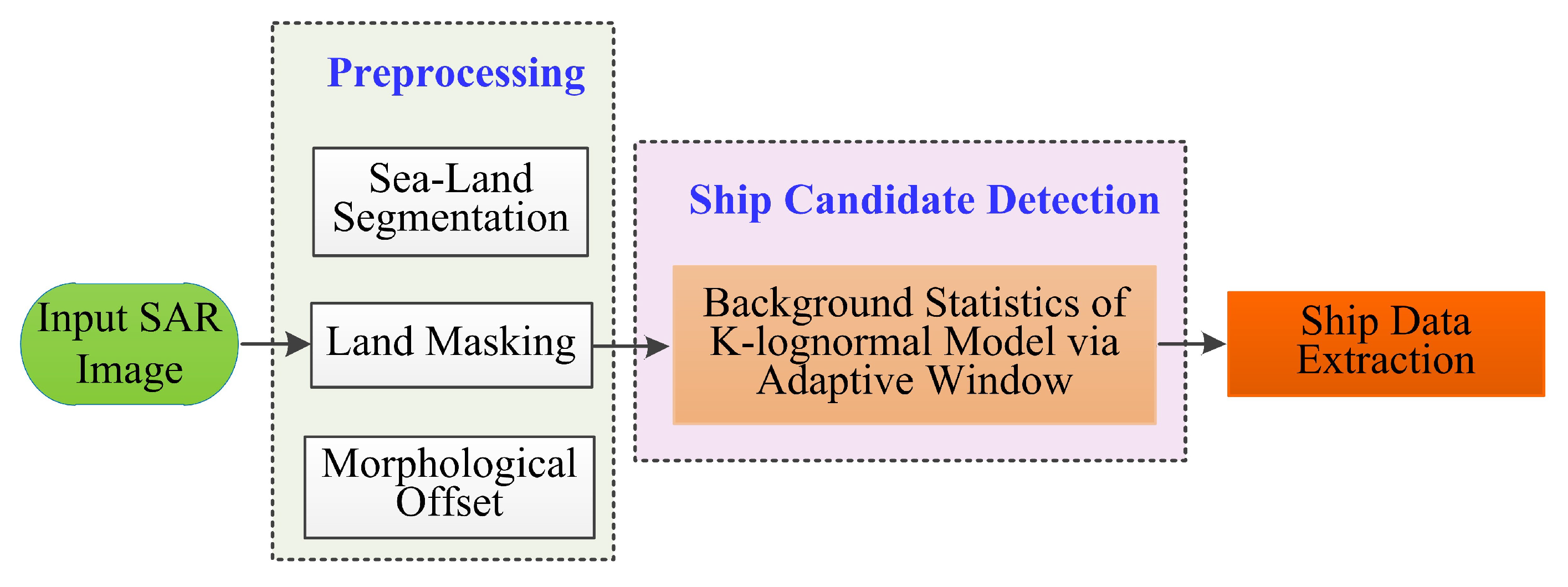
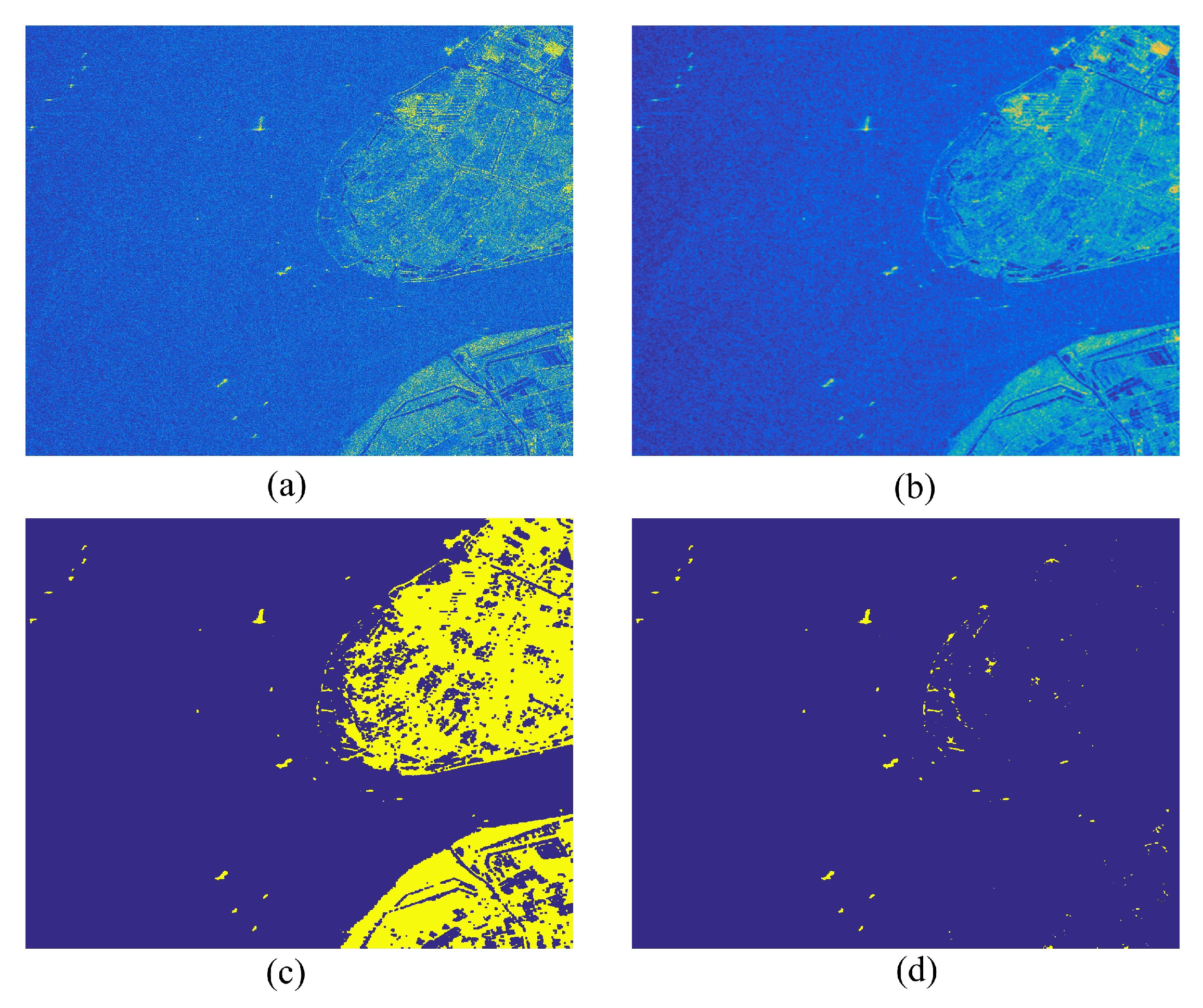


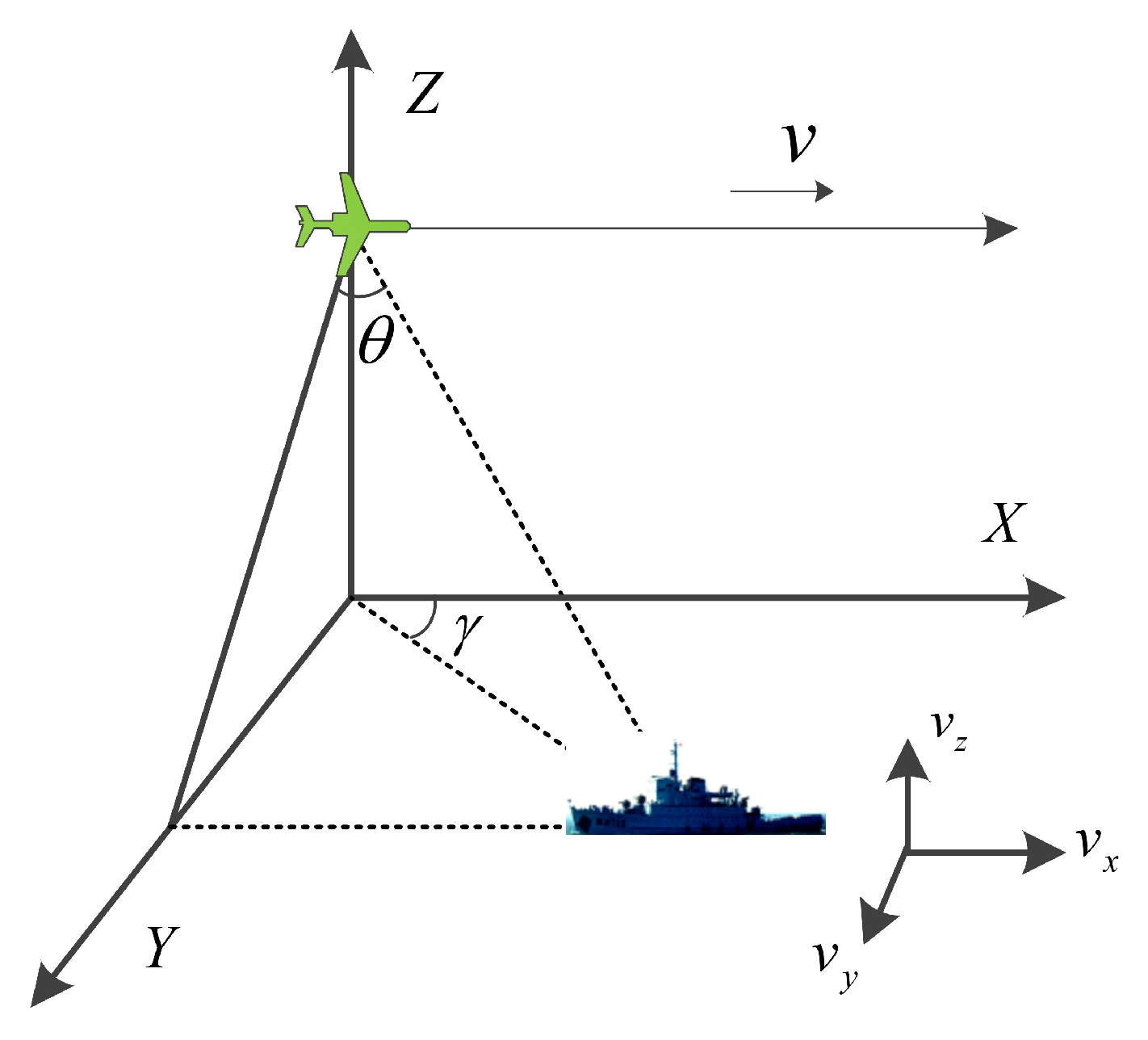
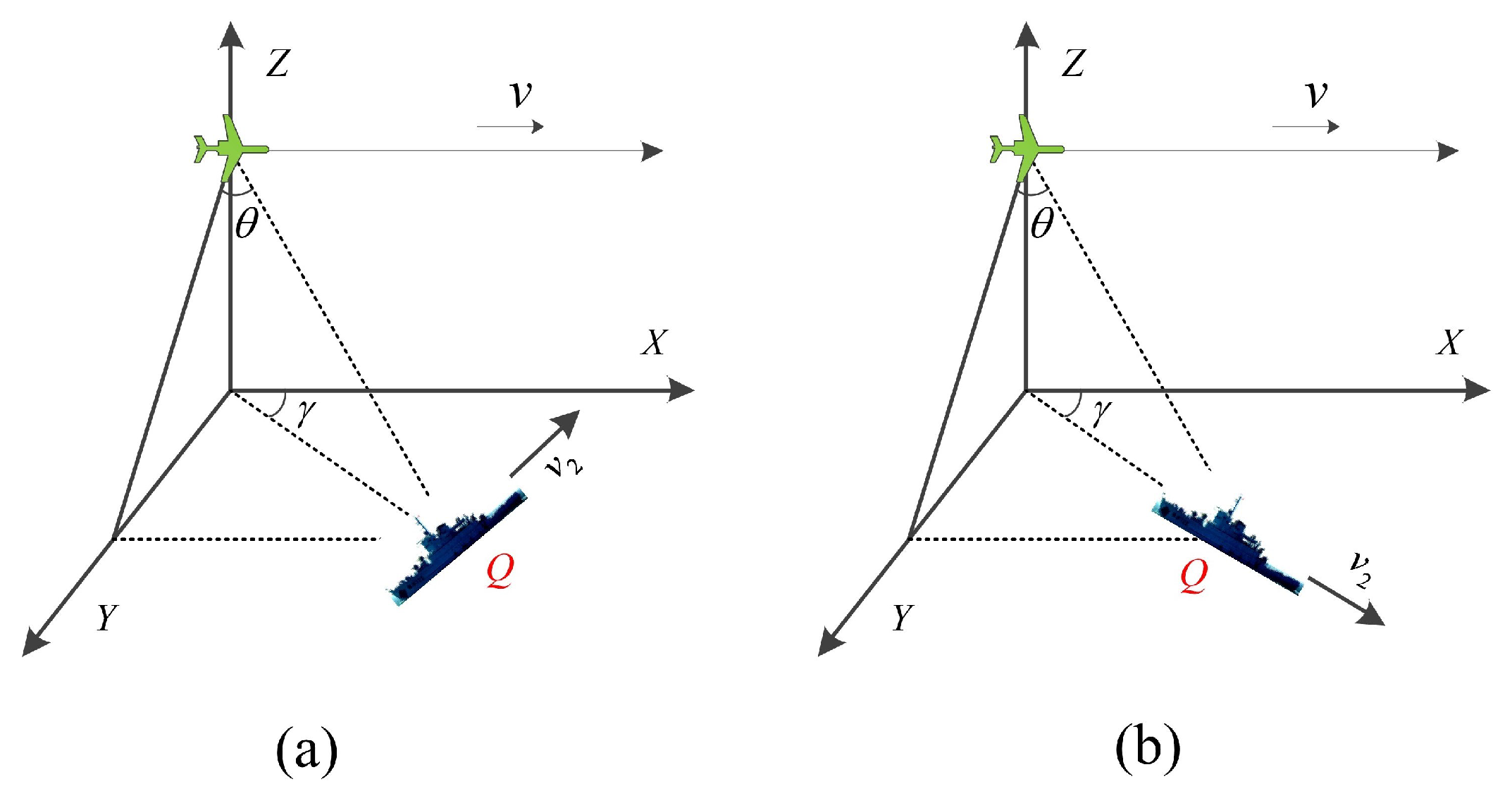
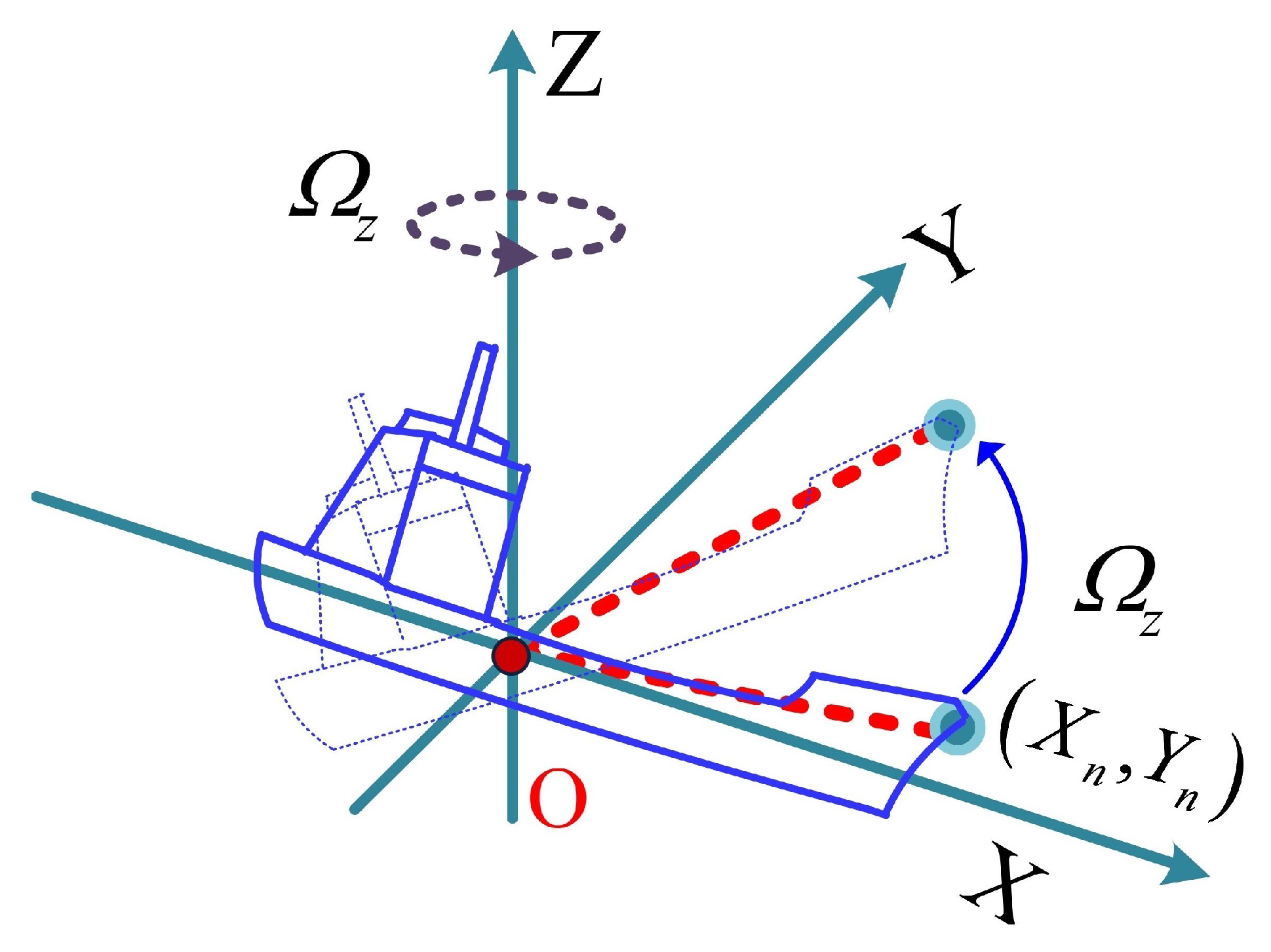
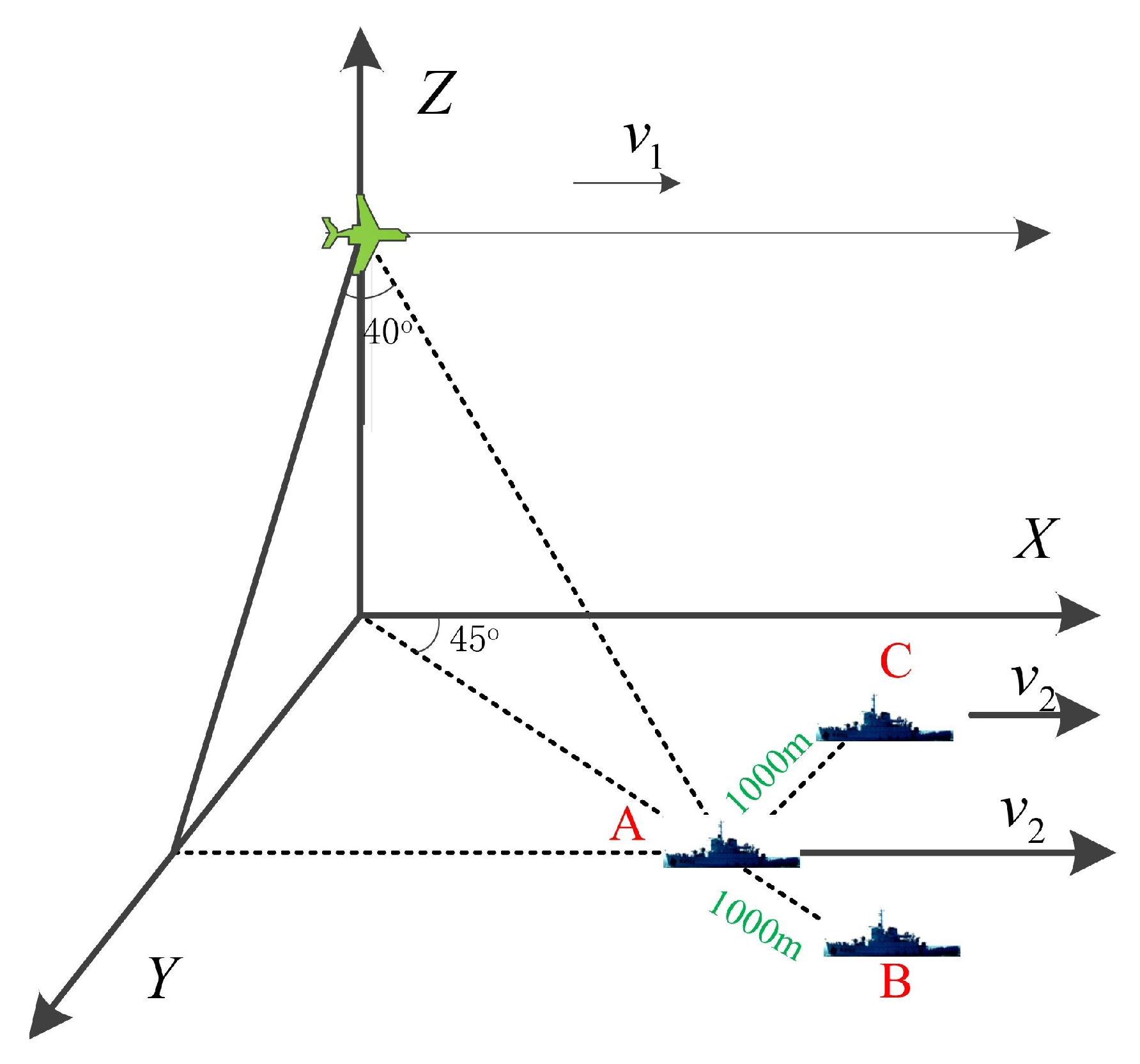
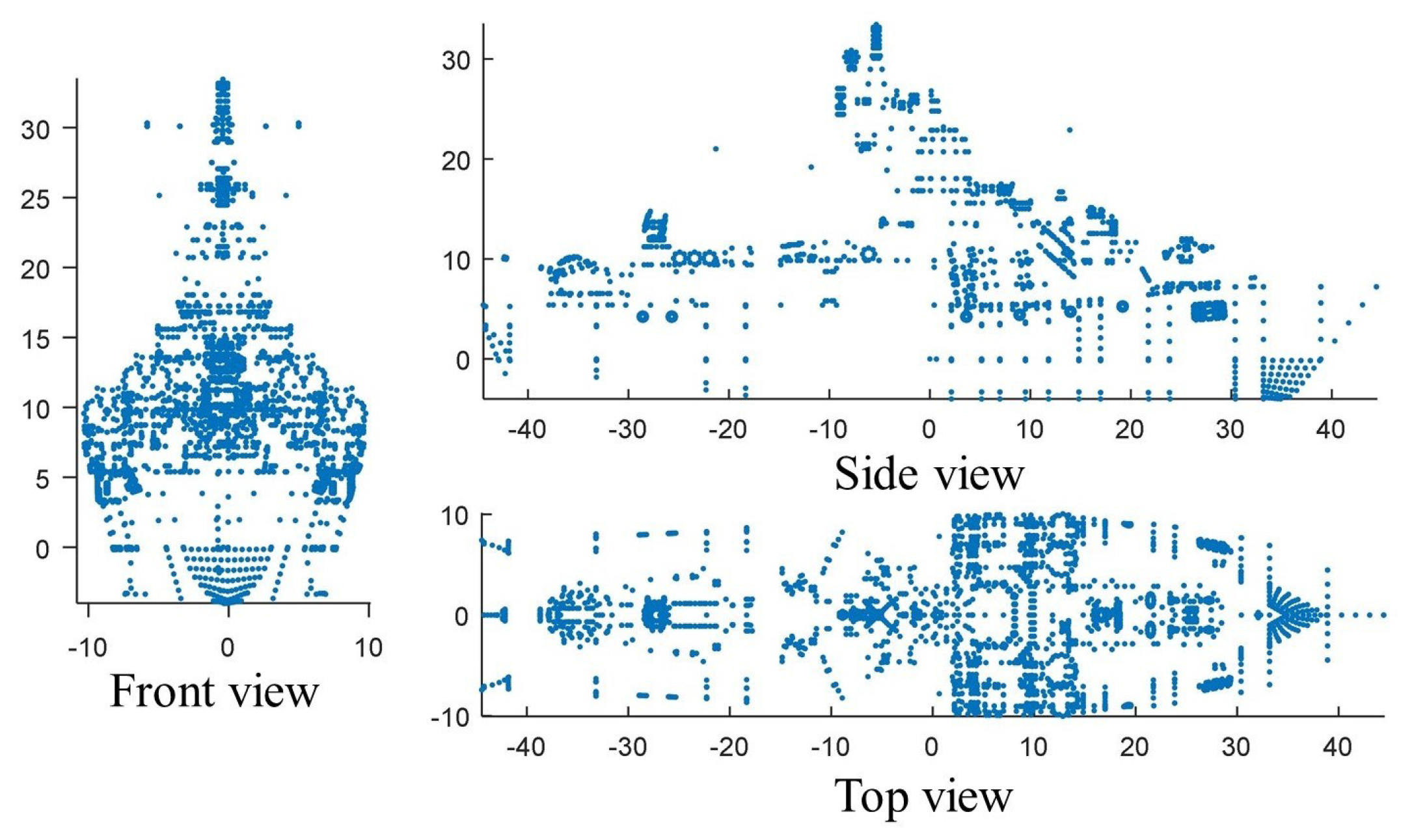


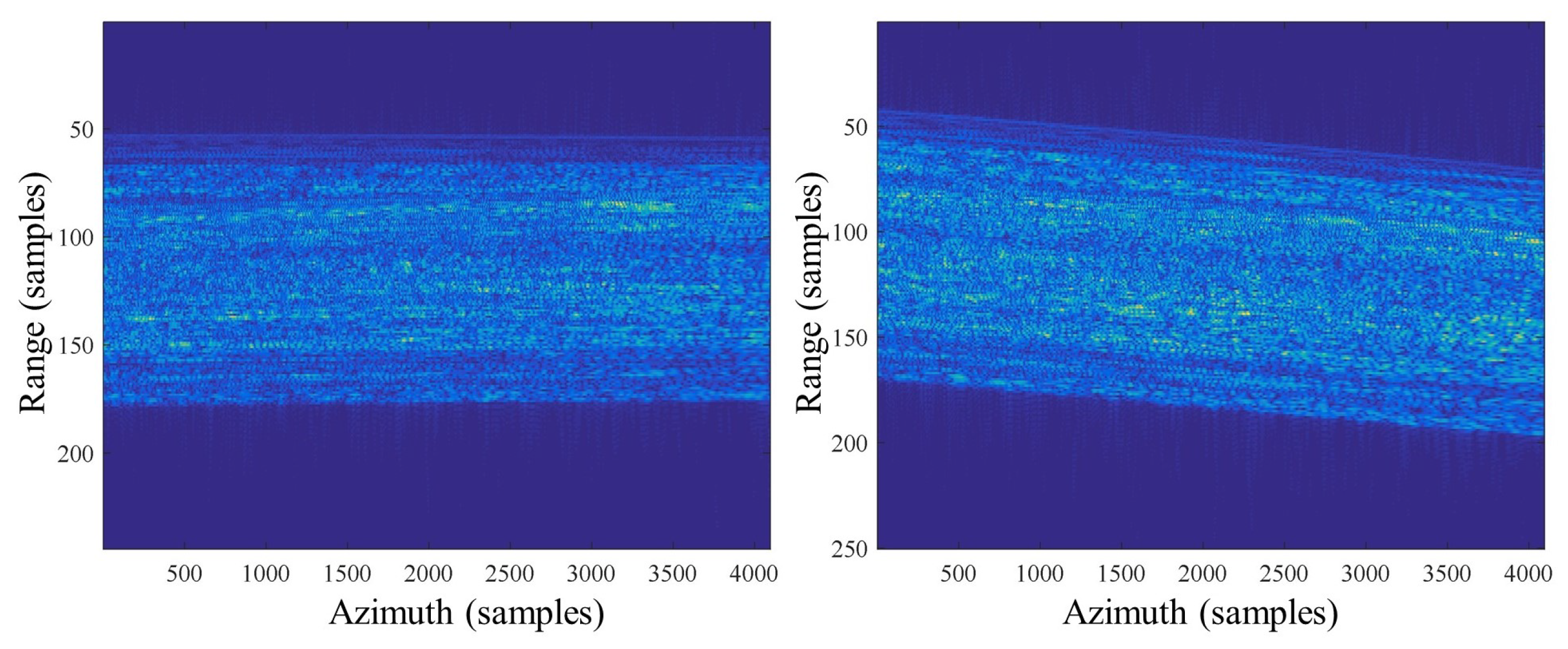

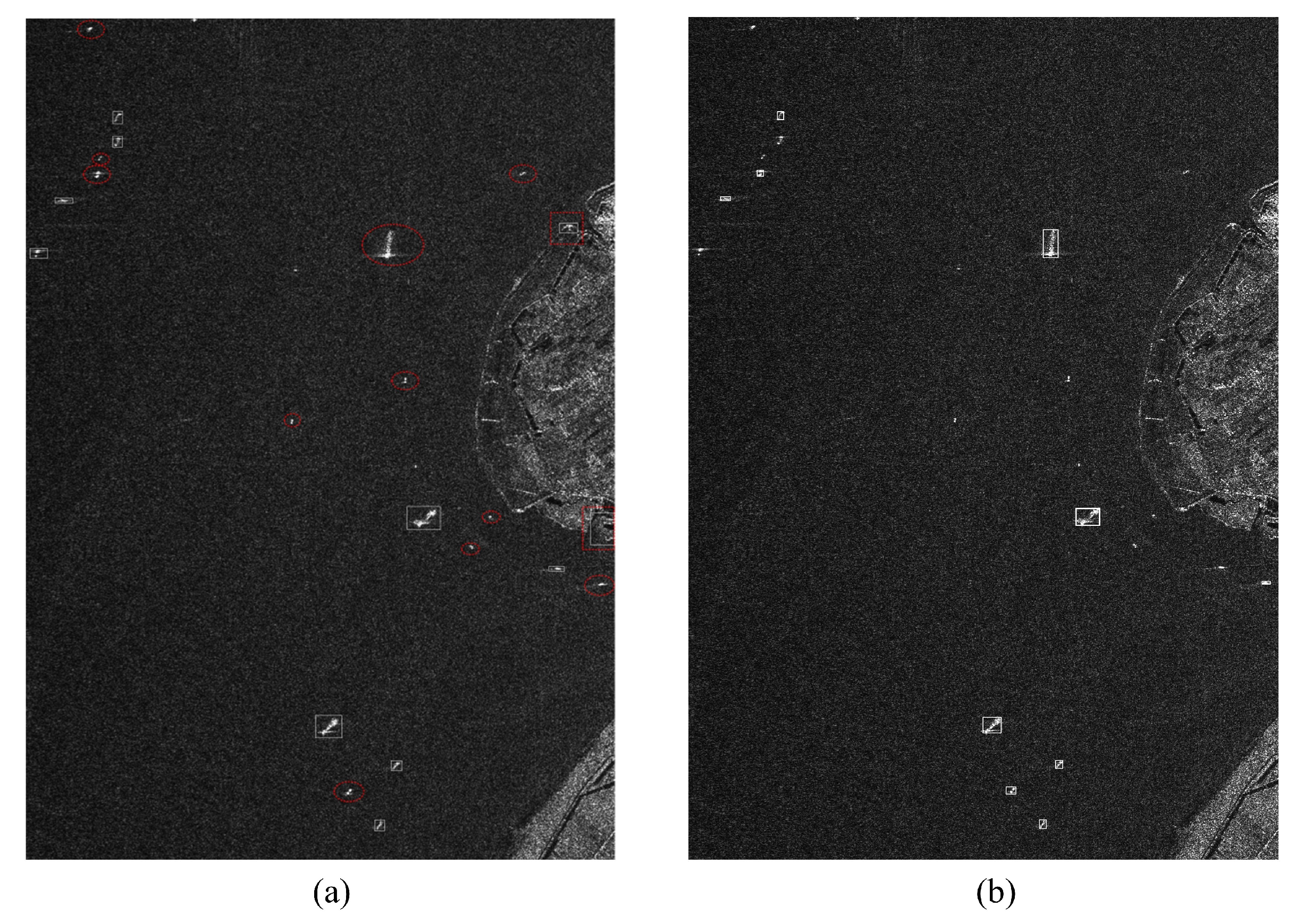
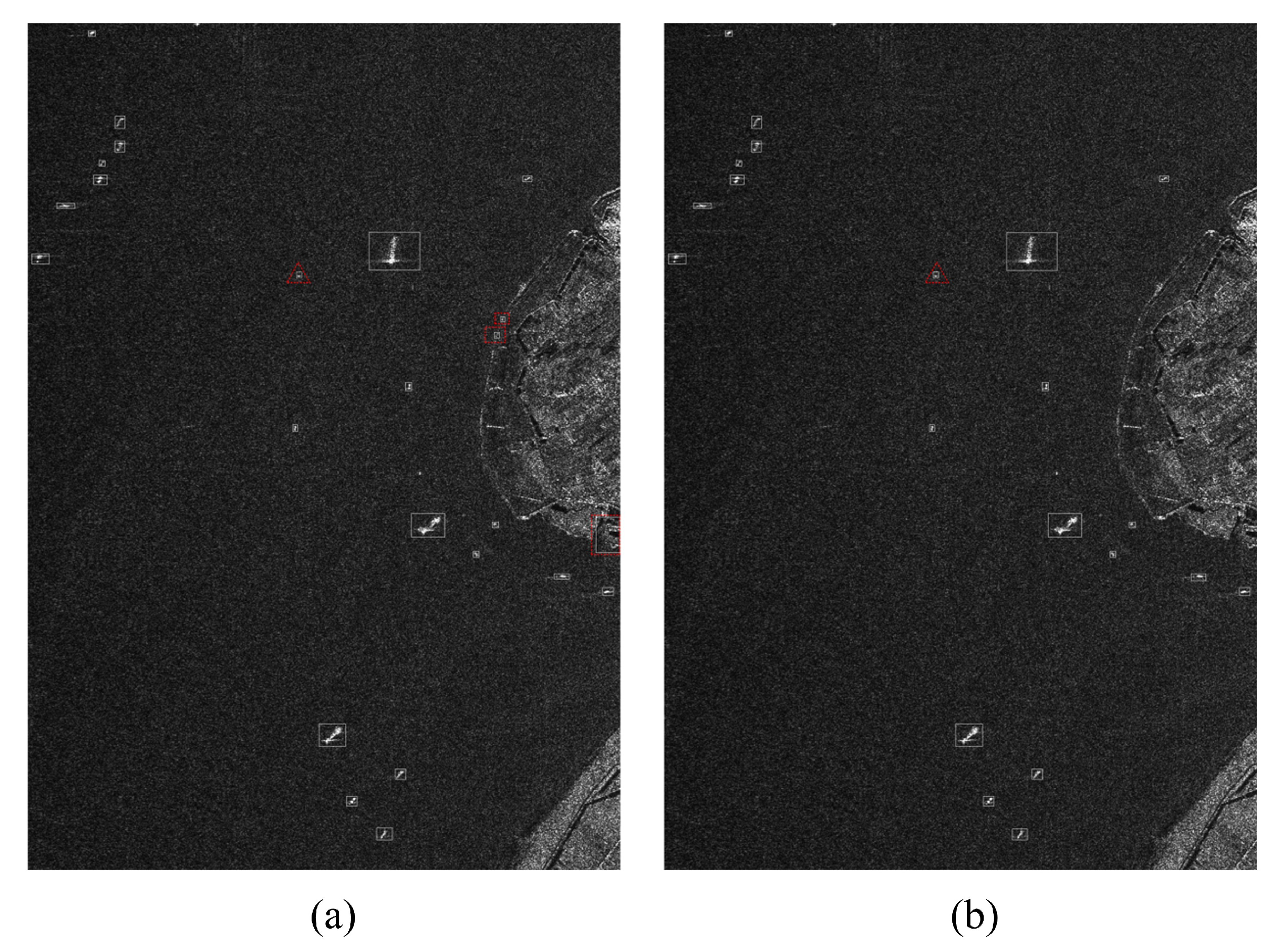
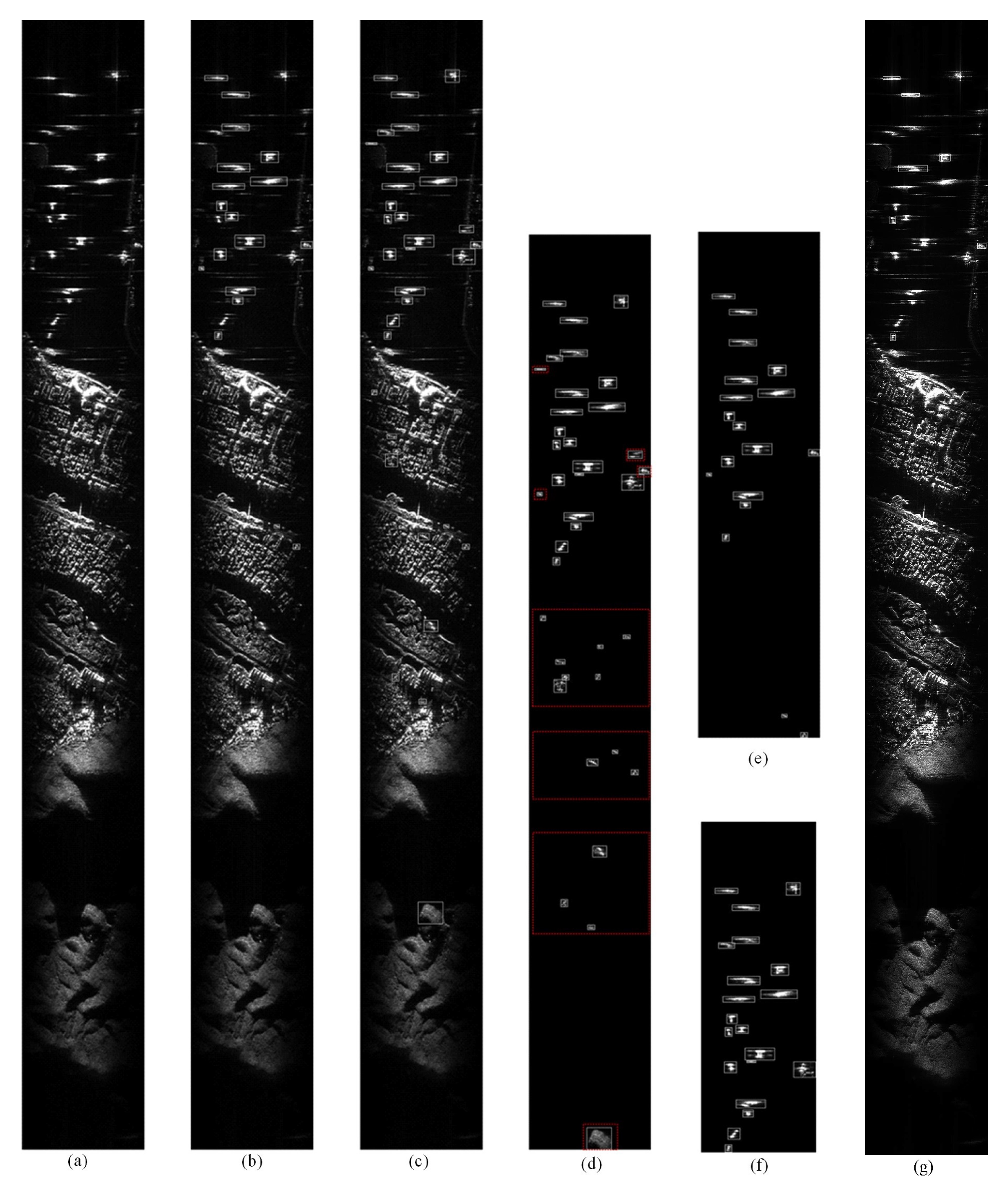
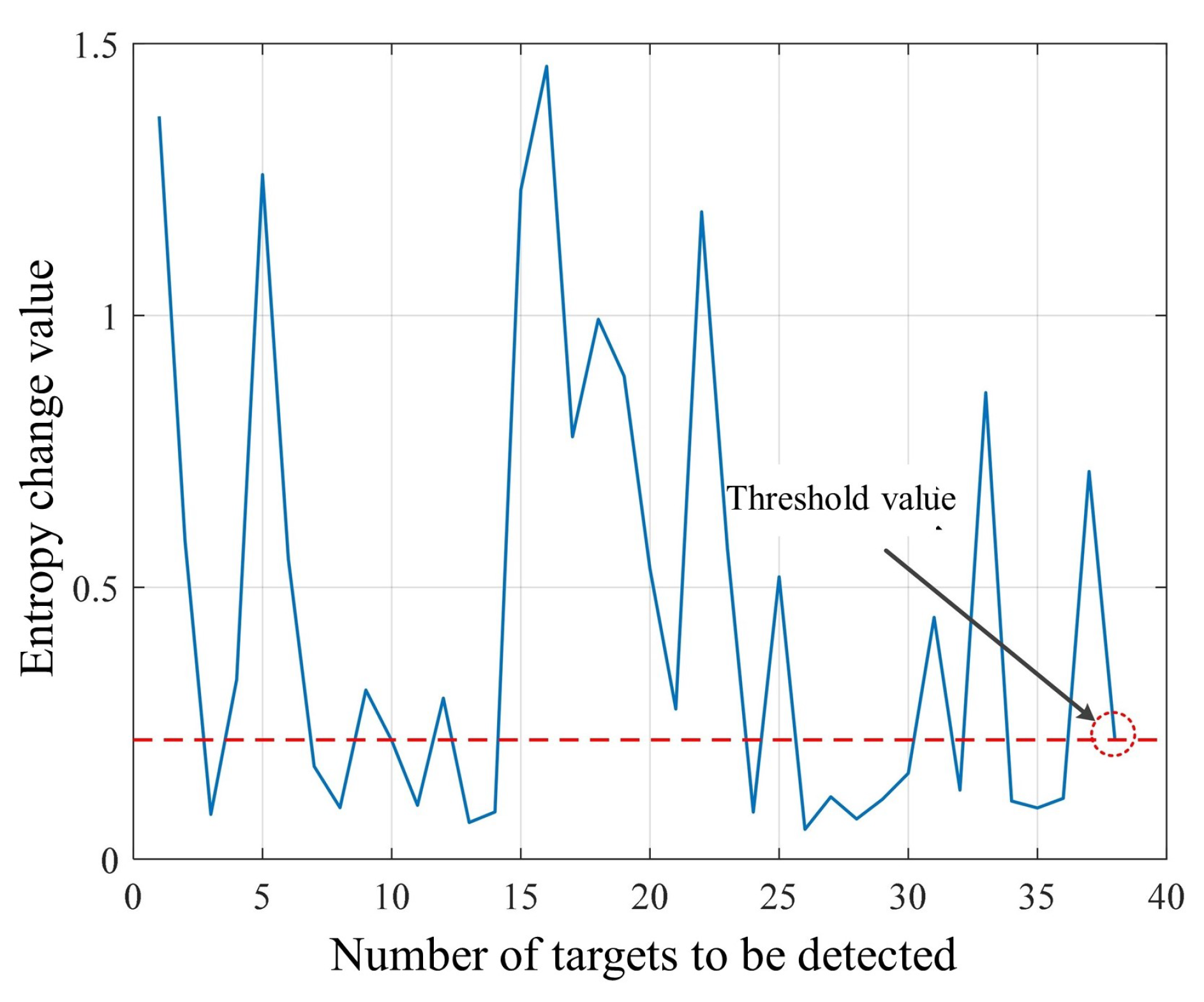
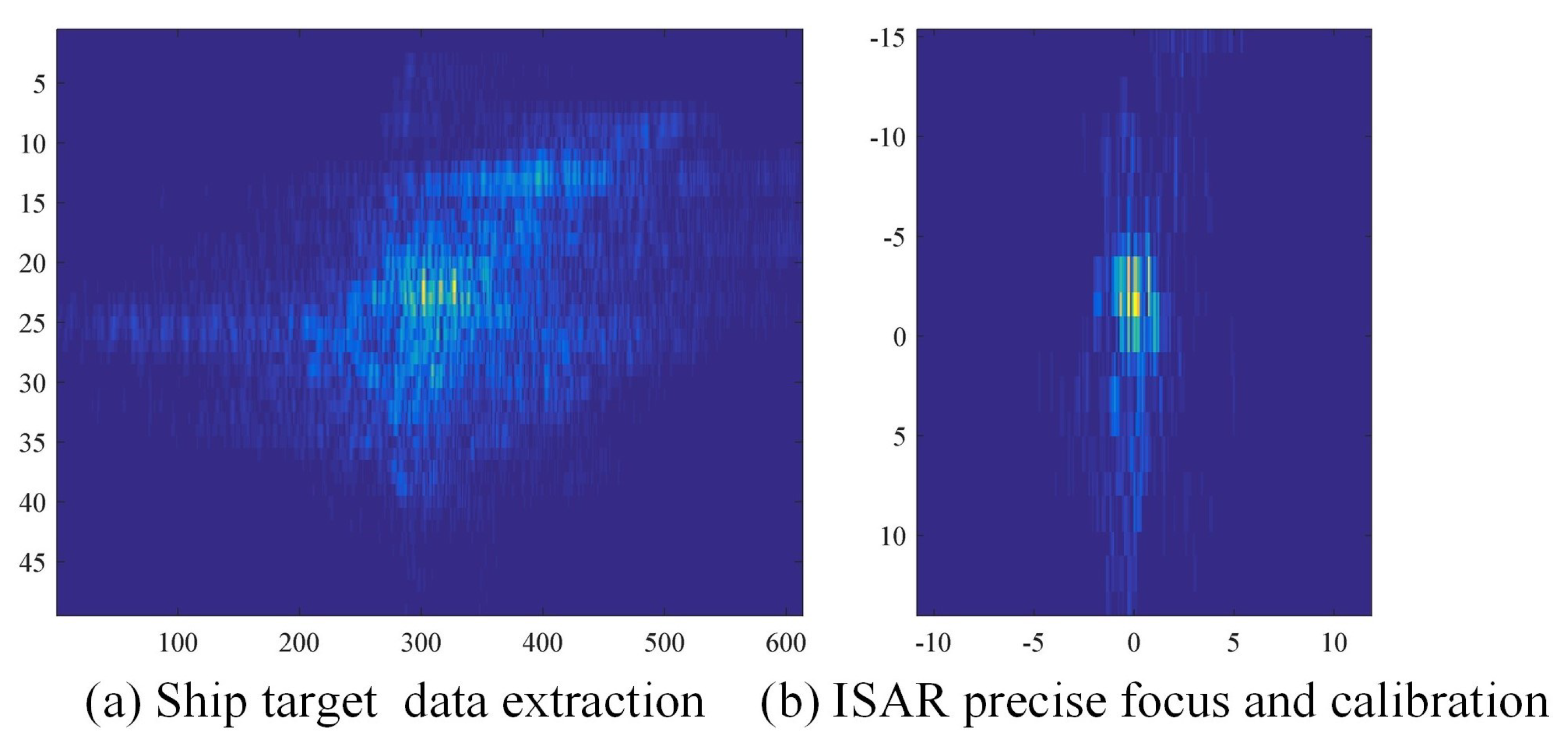
| Carrier frequency | 9.6 GHz | PRF | 2 KHz |
| Range bandwidth | 200 MHz | Height | 15 km |
| Range sampling rate | 240 MHz | Slant | 35 km |
| Azimuth accumulation time | 2 s | Velocity | 150 m/s |
| Azimuth angle | 45 | Squint angle | 40 |
| Pulse width | 40 s | Range chirp rate |
| Size | (88, 19.8, 33) m | Speed | (0, 10, 10) m/s |
|---|---|---|---|
| Roll amplitude | 19.2 | Rolling period | 12.2 s |
| Yaw amplitude | 1.9 | Yaw period | 14.2 s |
| Pitch amplitude | 1.7 | Pitch period | 6.7 s |
| Parameters | Reference Algorithm in [37] | YOLOx | Rough Detection | Precise Detection |
|---|---|---|---|---|
| Number of correct tests | 9 | 7 | 17 | 20 |
| Actual number | 20 | 20 | 20 | 20 |
| False alarm number | 2 | 0 | 4 | 1 |
| Quality factor | 0.4091 | 0.3500 | 0.7083 | 0.9524 |
Publisher’s Note: MDPI stays neutral with regard to jurisdictional claims in published maps and institutional affiliations. |
© 2022 by the authors. Licensee MDPI, Basel, Switzerland. This article is an open access article distributed under the terms and conditions of the Creative Commons Attribution (CC BY) license (https://creativecommons.org/licenses/by/4.0/).
Share and Cite
Li, Z.; Chen, J.; Xiong, Y.; Yu, H.; Zhang, H.; Gao, B. A Ship Detection and Imagery Scheme for Airborne Single-Channel SAR in Coastal Regions. Remote Sens. 2022, 14, 4670. https://doi.org/10.3390/rs14184670
Li Z, Chen J, Xiong Y, Yu H, Zhang H, Gao B. A Ship Detection and Imagery Scheme for Airborne Single-Channel SAR in Coastal Regions. Remote Sensing. 2022; 14(18):4670. https://doi.org/10.3390/rs14184670
Chicago/Turabian StyleLi, Zhenyu, Jianlai Chen, Yi Xiong, Hanwen Yu, Huaigen Zhang, and Bing Gao. 2022. "A Ship Detection and Imagery Scheme for Airborne Single-Channel SAR in Coastal Regions" Remote Sensing 14, no. 18: 4670. https://doi.org/10.3390/rs14184670
APA StyleLi, Z., Chen, J., Xiong, Y., Yu, H., Zhang, H., & Gao, B. (2022). A Ship Detection and Imagery Scheme for Airborne Single-Channel SAR in Coastal Regions. Remote Sensing, 14(18), 4670. https://doi.org/10.3390/rs14184670








